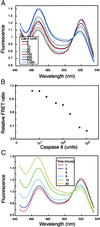Confirmation by FRET in individual living cells of the absence of significant amyloid beta -mediated caspase 8 activation
- PMID: 12409609
- PMCID: PMC137485
- DOI: 10.1073/pnas.232177599
Confirmation by FRET in individual living cells of the absence of significant amyloid beta -mediated caspase 8 activation
Abstract
When cells are exposed to death-inducing molecules such as tumor necrosis factor-alpha or Fas, caspase 8 is activated and cleaves an apoptotic facilitator, Bid, that is a member of the Bcl-2 family. After additional modification, the C-terminal moiety of Bid is translocated to the mitochondria and induces the release of cytochrome c into the cytoplasm. In an attempt to directly observe the cleavage of Bid and the following events in living cells, we constructed a vector that encoded Bid fused with yellow fluorescent protein (YFP) and cyan fluorescent protein (CFP) (YFP-Bid-CFP). On expression of YFP-Bid-CFP in mammalian cells, we were able to observe the efficient transfer of energy from excited CFP to YFP within the YFP-Bid-CFP molecule and, importantly, the fusion protein YFP-Bid-CFP was fully functional in cells. When YFP-Bid-CFP was cleaved by caspase 8, on activation by anti-Fas Abs but not by Abeta or tunicamycin, no such transfer of energy was detected. To our knowledge, this is the first report of (i) visualization of the activation of Bid by proteolytic cleavage, with direct observation of the cleavage of YFP-Bid-CFP in the cytoplasm and subsequent translocation of the cleaved Bid to mitochondria and (ii) the absence of Abeta- or tunicamycin-mediated significant activation of caspase 8 in individual living cells.
Figures





Similar articles
-
A flow cytometric method to detect protein-protein interaction in living cells by directly visualizing donor fluorophore quenching during CFP-->YFP fluorescence resonance energy transfer (FRET).Cytometry A. 2003 Oct;55(2):71-85. doi: 10.1002/cyto.a.10073. Cytometry A. 2003. PMID: 14505312
-
Cadmium induces apoptotic cell death in WI 38 cells via caspase-dependent Bid cleavage and calpain-mediated mitochondrial Bax cleavage by Bcl-2-independent pathway.Biochem Pharmacol. 2004 Nov 1;68(9):1845-55. doi: 10.1016/j.bcp.2004.06.021. Biochem Pharmacol. 2004. PMID: 15450950
-
Flow cytometric measurement of fluorescence (Förster) resonance energy transfer from cyan fluorescent protein to yellow fluorescent protein using single-laser excitation at 458 nm.Cytometry A. 2003 May;53(1):39-54. doi: 10.1002/cyto.a.10037. Cytometry A. 2003. PMID: 12701131
-
Signal transduction mediated by Bid, a pro-death Bcl-2 family proteins, connects the death receptor and mitochondria apoptosis pathways.Cell Res. 2000 Sep;10(3):161-7. doi: 10.1038/sj.cr.7290045. Cell Res. 2000. PMID: 11032168 Review.
-
The roles of Bid.Apoptosis. 2002 Oct;7(5):433-40. doi: 10.1023/a:1020035124855. Apoptosis. 2002. PMID: 12207176 Review.
Cited by
-
A functional gene discovery in the Fas-mediated pathway to apoptosis by analysis of transiently expressed randomized hybrid-ribozyme libraries.Nucleic Acids Res. 2002 Aug 15;30(16):3609-14. doi: 10.1093/nar/gkf476. Nucleic Acids Res. 2002. PMID: 12177303 Free PMC article.
-
Plant caspase-like proteases in plant programmed cell death.Plant Signal Behav. 2009 Sep;4(9):902-4. doi: 10.4161/psb.4.9.9531. Plant Signal Behav. 2009. PMID: 19938376 Free PMC article.
-
Developments in preclinical cancer imaging: innovating the discovery of therapeutics.Nat Rev Cancer. 2014 May;14(5):314-28. doi: 10.1038/nrc3724. Epub 2014 Apr 17. Nat Rev Cancer. 2014. PMID: 24739578 Review.
-
Gene delivery ability of polyethylenimine and polyethylene glycol dual-functionalized nanographene oxide in 11 different cell lines.R Soc Open Sci. 2017 Oct 25;4(10):170822. doi: 10.1098/rsos.170822. eCollection 2017 Oct. R Soc Open Sci. 2017. PMID: 29134085 Free PMC article.
-
Small Molecule Active Site Directed Tools for Studying Human Caspases.Chem Rev. 2015 Nov 25;115(22):12546-629. doi: 10.1021/acs.chemrev.5b00434. Epub 2015 Nov 9. Chem Rev. 2015. PMID: 26551511 Free PMC article. Review.
References
-
- Li H. & Yuan, J. (1999) Curr. Opin. Cell Biol. 11, 261-266. - PubMed
-
- Korsmeyer S. J., Wei, M. C., Saito, M., Weiler, S., Oh, K. & Schlesinger, P. H. (2000) Cell Death Differ. 7, 1166-1173. - PubMed
-
- Wang K., Yin, X. M., Chao, D. T., Milliman, C. L. & Korsmeyer, S. J. (1996) Genes Dev. 10, 2859-2869. - PubMed
-
- Gross A., Yin, X. M., Wang, K., Wei, M. C., Jockel, J., Milliman, C., Erdjument-Bromage, H., Tempst, P. & Korsmeyer, S. J. (1999) J. Biol. Chem. 274, 1156-1163. - PubMed
Publication types
MeSH terms
Substances
LinkOut - more resources
Full Text Sources
Other Literature Sources
Research Materials
Miscellaneous

